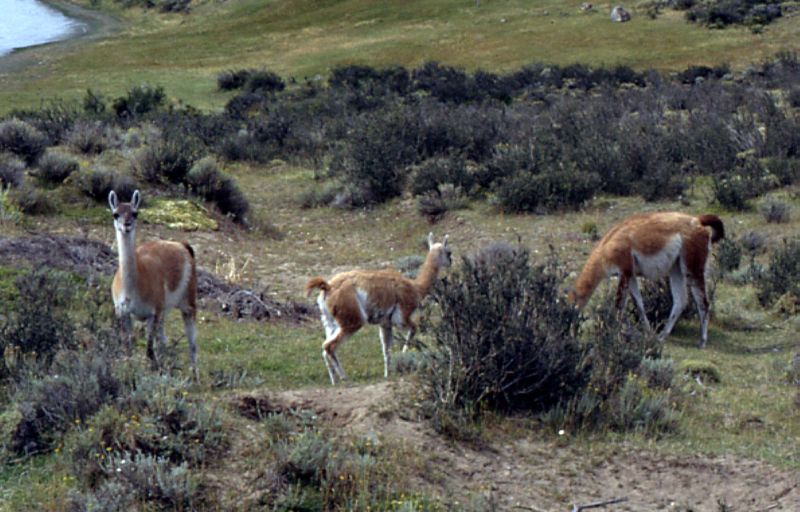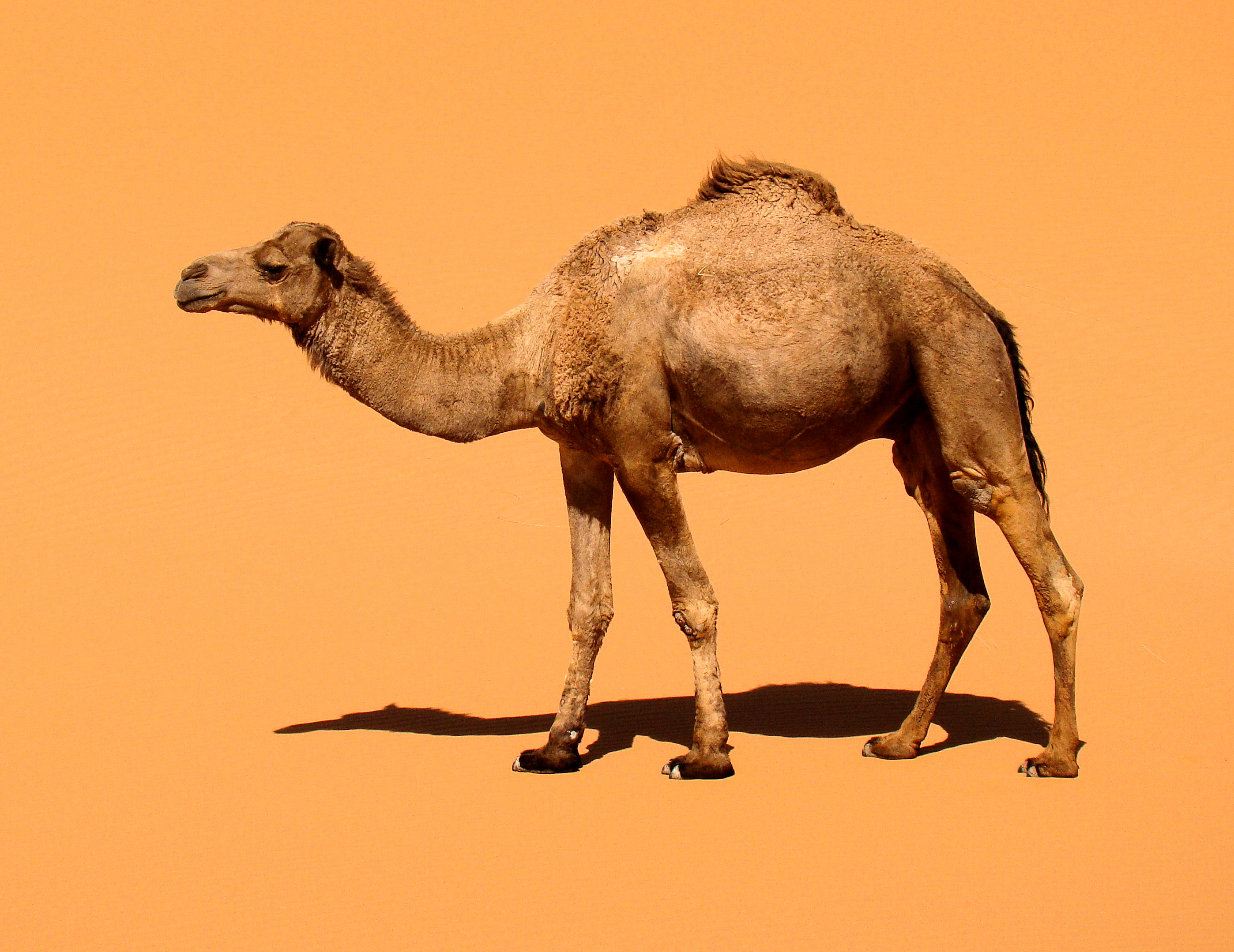|
Vicugna
'''' is a genus containing four South American camelids, the wild guanaco and vicuña, and the domesticated llama and alpaca. Before the Spanish conquest of the Americas, llamas and alpacas were the only domesticated ungulates of the continent. They were kept not only for their value as beasts of burden, but also for their flesh, hides, and wool. Classification Although they were often compared to sheep by early writers, their affinity to the camel was soon perceived. They were included in the genus ''Camelus'' in the ''Systema Naturae'' of Linnaeus. In 1800, Cuvier moved the llama, alpaca, and guanaco to the genus ''Lama'', and the vicuña to the genus ''Vicugna''. Later, the alpaca was transferred to ''Vicugna''; both were eventually returned to ''Lama'' by the American Society of Mammalogists in 2021. These camelids are, with the two species of true camels, the sole extant representatives of a distinct section of Artiodactyla (even-toed ungulates) called Tylopoda, or "hu ... [...More Info...] [...Related Items...] OR: [Wikipedia] [Google] [Baidu] |
Vicuña
The vicuña (''Lama vicugna'') or vicuna (both , very rarely spelled ''vicugna'', its former genus name) is one of the two wild South American camelids, which live in the high alpine areas of the Andes, the other being the guanaco, which lives at lower elevations. Vicuñas are relatives of the llama, and are now believed to be the wild ancestor of domesticated alpacas, which are raised for their coats. Vicuñas produce small amounts of extremely fine wool, which is very expensive because the animal can only be shorn every three years and has to be caught from the wild. When knitted together, the product of the vicuña's wool is very soft and warm. The Inca valued vicuñas highly for their wool, and it was against the law for anyone but royalty to wear vicuña garments; today, the vicuña is the national animal of Peru and appears on the Peruvian coat of arms. Both under the rule of the Inca and today, vicuñas have been protected by law, but they were heavily hunted in the in ... [...More Info...] [...Related Items...] OR: [Wikipedia] [Google] [Baidu] |
Vicuña
The vicuña (''Lama vicugna'') or vicuna (both , very rarely spelled ''vicugna'', its former genus name) is one of the two wild South American camelids, which live in the high alpine areas of the Andes, the other being the guanaco, which lives at lower elevations. Vicuñas are relatives of the llama, and are now believed to be the wild ancestor of domesticated alpacas, which are raised for their coats. Vicuñas produce small amounts of extremely fine wool, which is very expensive because the animal can only be shorn every three years and has to be caught from the wild. When knitted together, the product of the vicuña's wool is very soft and warm. The Inca valued vicuñas highly for their wool, and it was against the law for anyone but royalty to wear vicuña garments; today, the vicuña is the national animal of Peru and appears on the Peruvian coat of arms. Both under the rule of the Inca and today, vicuñas have been protected by law, but they were heavily hunted in the in ... [...More Info...] [...Related Items...] OR: [Wikipedia] [Google] [Baidu] |
Alpaca
The alpaca (''Lama pacos'') is a species of South American camelid mammal. It is similar to, and often confused with, the llama. However, alpacas are often noticeably smaller than llamas. The two animals are closely related and can successfully crossbreed. Both species are believed to have been domesticated from their wild relatives, the vicuña and guanaco. There are two breeds of alpaca: the Suri alpaca and the Huacaya alpaca. Alpacas are kept in herds that graze on the level heights of the Andes of Southern Peru, Western Bolivia, Ecuador, and Northern Chile at an altitude of above sea level. Alpacas are considerably smaller than llamas, and unlike llamas, they were not bred to be working animals, but were bred specifically for their fiber. Alpaca fiber is used for making knitted and woven items, similar to sheep's wool. These items include blankets, sweaters, hats, gloves, scarves, a wide variety of textiles, and ponchos, in South America, as well as sweaters, socks, coat ... [...More Info...] [...Related Items...] OR: [Wikipedia] [Google] [Baidu] |
Alpaca
The alpaca (''Lama pacos'') is a species of South American camelid mammal. It is similar to, and often confused with, the llama. However, alpacas are often noticeably smaller than llamas. The two animals are closely related and can successfully crossbreed. Both species are believed to have been domesticated from their wild relatives, the vicuña and guanaco. There are two breeds of alpaca: the Suri alpaca and the Huacaya alpaca. Alpacas are kept in herds that graze on the level heights of the Andes of Southern Peru, Western Bolivia, Ecuador, and Northern Chile at an altitude of above sea level. Alpacas are considerably smaller than llamas, and unlike llamas, they were not bred to be working animals, but were bred specifically for their fiber. Alpaca fiber is used for making knitted and woven items, similar to sheep's wool. These items include blankets, sweaters, hats, gloves, scarves, a wide variety of textiles, and ponchos, in South America, as well as sweaters, socks, coat ... [...More Info...] [...Related Items...] OR: [Wikipedia] [Google] [Baidu] |
Llama
The llama (; ) (''Lama glama'') is a domesticated South American camelid, widely used as a List of meat animals, meat and pack animal by Inca empire, Andean cultures since the Pre-Columbian era. Llamas are social animals and live with others as a herd. Their wool is soft and contains only a small amount of lanolin. Llamas can learn simple tasks after a few repetitions. When using a pack, they can carry about 25 to 30% of their body weight for 8 to 13 kilometre, km (5–8 miles). The name ''llama'' (in the past also spelled "lama" or "glama") was adopted by European colonization of the Americas, European settlers from Indigenous people in Peru, native Peruvians. The ancestors of llamas are thought to have originated from the Great Plains of North America about 40 million years ago, and subsequently migrated to South America about three million years ago during the Great American Interchange. By the end of the last Quaternary glaciation, ice age (10,000–12,000 years ago), ... [...More Info...] [...Related Items...] OR: [Wikipedia] [Google] [Baidu] |
Llama
The llama (; ) (''Lama glama'') is a domesticated South American camelid, widely used as a List of meat animals, meat and pack animal by Inca empire, Andean cultures since the Pre-Columbian era. Llamas are social animals and live with others as a herd. Their wool is soft and contains only a small amount of lanolin. Llamas can learn simple tasks after a few repetitions. When using a pack, they can carry about 25 to 30% of their body weight for 8 to 13 kilometre, km (5–8 miles). The name ''llama'' (in the past also spelled "lama" or "glama") was adopted by European colonization of the Americas, European settlers from Indigenous people in Peru, native Peruvians. The ancestors of llamas are thought to have originated from the Great Plains of North America about 40 million years ago, and subsequently migrated to South America about three million years ago during the Great American Interchange. By the end of the last Quaternary glaciation, ice age (10,000–12,000 years ago), ... [...More Info...] [...Related Items...] OR: [Wikipedia] [Google] [Baidu] |
Lama Glama
The llama (; ) (''Lama glama'') is a domesticated South American camelid, widely used as a meat and pack animal by Andean cultures since the Pre-Columbian era. Llamas are social animals and live with others as a herd. Their wool is soft and contains only a small amount of lanolin. Llamas can learn simple tasks after a few repetitions. When using a pack, they can carry about 25 to 30% of their body weight for 8 to 13 km (5–8 miles). The name ''llama'' (in the past also spelled "lama" or "glama") was adopted by European settlers from native Peruvians. The ancestors of llamas are thought to have originated from the Great Plains of North America about 40 million years ago, and subsequently migrated to South America about three million years ago during the Great American Interchange. By the end of the last ice age (10,000–12,000 years ago), camelids were extinct in North America. As of 2007, there were over seven million llamas and alpacas in South America and over 158,00 ... [...More Info...] [...Related Items...] OR: [Wikipedia] [Google] [Baidu] |
Camelid
Camelids are members of the biological family Camelidae, the only currently living family in the suborder Tylopoda. The seven extant members of this group are: dromedary camels, Bactrian camels, wild Bactrian camels, llamas, alpacas, vicuñas, and guanacos. Camelids are even-toed ungulates classified in the order Cetartiodactyla, along with species like whales, pigs, deer, cattle, and antelopes. Characteristics Camelids are large, strictly herbivorous animals with slender necks and long legs. They differ from ruminants in a number of ways.Fowler, M.E. (2010). ''Medicine and Surgery of Camelids'', Ames, Iowa: Wiley-Blackwell. Chapter 1 "General Biology and Evolution" addresses the fact that camelids (including camels and llamas) are not ruminants, pseudo-ruminants, or modified ruminants. Their dentition show traces of vestigial central incisors in the incisive bone, and the third incisors have developed into canine-like tusks. Camelids also have true canine teeth and tusk-lik ... [...More Info...] [...Related Items...] OR: [Wikipedia] [Google] [Baidu] |
Camelidae
Camelids are members of the biological family Camelidae, the only currently living family in the suborder Tylopoda. The seven extant members of this group are: dromedary camels, Bactrian camels, wild Bactrian camels, llamas, alpacas, vicuñas, and guanacos. Camelids are even-toed ungulates classified in the order Cetartiodactyla, along with species like whales, pigs, deer, cattle, and antelopes. Characteristics Camelids are large, strictly herbivorous animals with slender necks and long legs. They differ from ruminants in a number of ways.Fowler, M.E. (2010). ''Medicine and Surgery of Camelids'', Ames, Iowa: Wiley-Blackwell. Chapter 1 "General Biology and Evolution" addresses the fact that camelids (including camels and llamas) are not ruminants, pseudo-ruminants, or modified ruminants. Their dentition show traces of vestigial central incisors in the incisive bone, and the third incisors have developed into canine-like tusks. Camelids also have true canine teeth and tusk-lik ... [...More Info...] [...Related Items...] OR: [Wikipedia] [Google] [Baidu] |
Camel
A camel (from: la, camelus and grc-gre, κάμηλος (''kamēlos'') from Hebrew or Phoenician: גָמָל ''gāmāl''.) is an even-toed ungulate in the genus ''Camelus'' that bears distinctive fatty deposits known as "humps" on its back. Camels have long been domesticated and, as livestock, they provide food (milk and meat) and textiles (fiber and felt from hair). Camels are working animals especially suited to their desert habitat and are a vital means of transport for passengers and cargo. There are three surviving species of camel. The one-humped dromedary makes up 94% of the world's camel population, and the two-humped Bactrian camel makes up 6%. The Wild Bactrian camel is a separate species and is now critically endangered. The word ''camel'' is also used informally in a wider sense, where the more correct term is "camelid", to include all seven species of the family Camelidae: the true camels (the above three species), along with the "New World" camelids: the llama, ... [...More Info...] [...Related Items...] OR: [Wikipedia] [Google] [Baidu] |
Camelus
A camel (from: la, camelus and grc-gre, κάμηλος (''kamēlos'') from Hebrew or Phoenician: גָמָל ''gāmāl''.) is an even-toed ungulate in the genus ''Camelus'' that bears distinctive fatty deposits known as "humps" on its back. Camels have long been domesticated and, as livestock, they provide food (milk and meat) and textiles (fiber and felt from hair). Camels are working animals especially suited to their desert habitat and are a vital means of transport for passengers and cargo. There are three surviving species of camel. The one-humped dromedary makes up 94% of the world's camel population, and the two-humped Bactrian camel makes up 6%. The Wild Bactrian camel is a separate species and is now critically endangered. The word ''camel'' is also used informally in a wider sense, where the more correct term is "camelid", to include all seven species of the family Camelidae: the true camels (the above three species), along with the "New World" camelids: the llama, ... [...More Info...] [...Related Items...] OR: [Wikipedia] [Google] [Baidu] |
Lama Guanicoe
Lama (; "chief") is a title for a teacher of the Dharma in Tibetan Buddhism. The name is similar to the Sanskrit term ''guru'', meaning "heavy one", endowed with qualities the student will eventually embody. The Tibetan word "lama" means "highest principle", and less literally "highest mother" or "highest parent" to show close relationship between teacher and student."lama" from Historically, the term was used for venerated spiritual masters or heads of . Today the title can be used as an [...More Info...] [...Related Items...] OR: [Wikipedia] [Google] [Baidu] |





.jpg)



